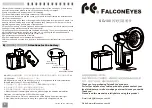
Misc
ellane
ous
248
11
Glossary of terms
A (Aperture Priority) Mode
You set the aperture yourself and the camera automatically varies the
shutter speed so that the picture is taken with the best exposure.
AE (Automatic Exposure)
The camera’s built-in exposure meter automatically sets the exposure. The 3
AE modes available on this camera are
P
mode, in which the camera selects
both the aperture and shutter speed,
A
mode, in which the user selects the
aperture and the camera sets the shutter speed, and
S
mode, in which the
user selects the shutter speed and the camera sets the aperture. In
M
mode,
the user selects both the aperture and the shutter speed.
Aperture
The adjustable lens opening which controls the amount of light that enters the
camera. The larger the aperture, the shorter the depth of field and the fuzzier the
background. The smaller the aperture, the greater the depth of field and the
sharper the background. Larger aperture values indicate smaller apertures, and
smaller aperture values indicate larger apertures.
Backlight
A light source to illuminate the monitor from behind the screen.
CCD (Charge-Coupled Device)
This converts light passing through the lens into electrical signals. On this
camera, light is picked up and converted into RGB signals to build a single
image.
Contrast Detection Method
This is used to measure the distance to the subject. The camera determines
if the image is focused by the level of contrast in the subject.
Conventional Photograph
This refers to recording images using silver halide (the method for recording
images in conventional, non-digital photography). This system is in contrast to
still video and digital photography.
DCF (Design rule for Camera File system)
A standard for image files by the Japan Electronics and Information
Technology Industries Association (JEITA).
Digital ESP (Electro-Selective Pattern) Light Metering
This determines the exposure by metering and calculating the light levels in
the center and other areas of the image separately.
















































